Reduce Contract Cycle Time in the Firm
VerifiedAdded on 2023/04/21
|14
|4361
|258
AI Summary
This article discusses the importance of reducing contract cycle time in a firm and provides strategies to improve efficiency. It explores the use of technology, centralized contract databases, and online management solutions. It also highlights the benefits of effective asset management and cost analysis. The article emphasizes the need for a win-win negotiation strategy and the integration of logistics and operations communities to decrease costs.
Contribute Materials
Your contribution can guide someone’s learning journey. Share your
documents today.
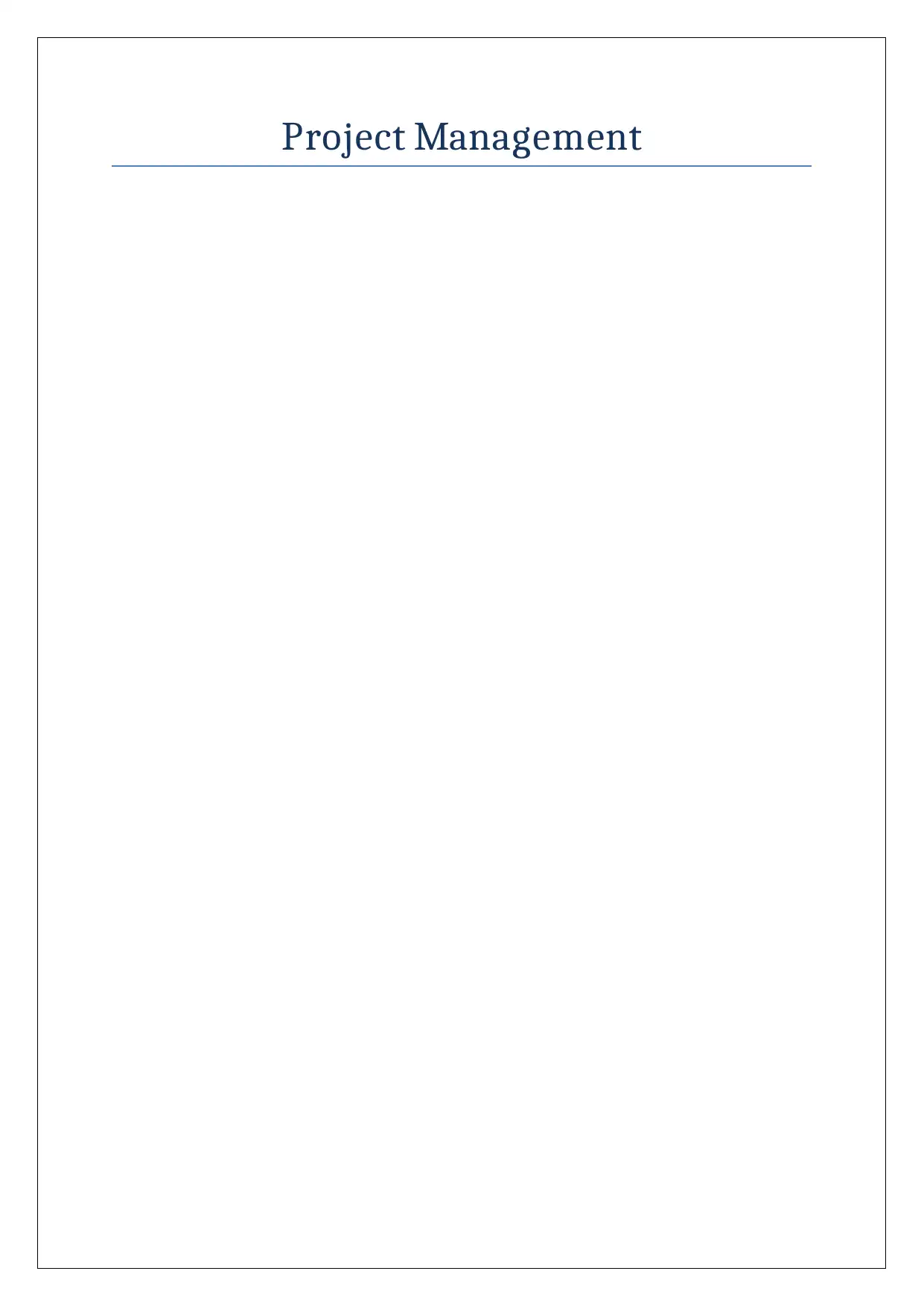
Project Management
Secure Best Marks with AI Grader
Need help grading? Try our AI Grader for instant feedback on your assignments.
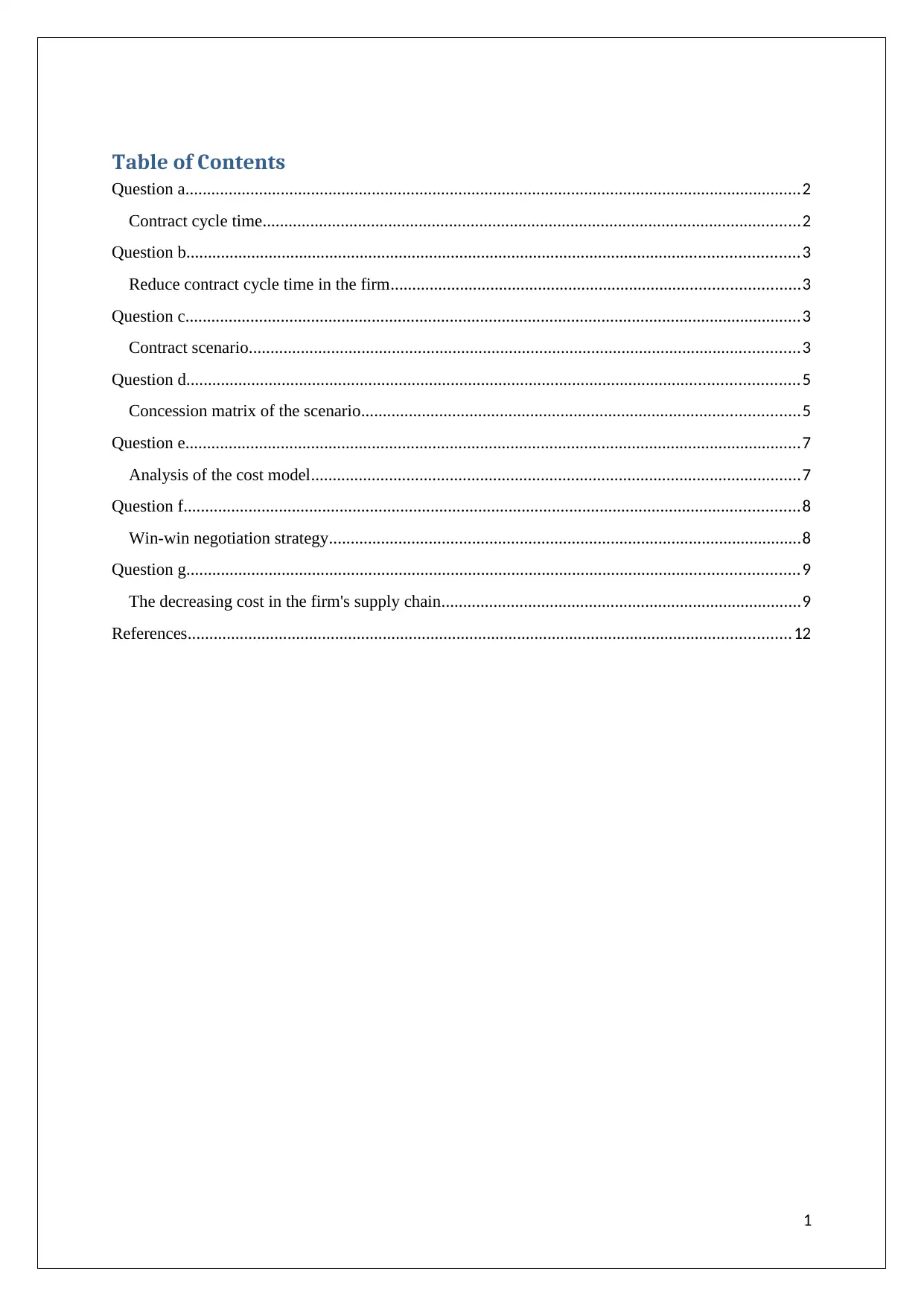
Table of Contents
Question a..............................................................................................................................................2
Contract cycle time............................................................................................................................2
Question b.............................................................................................................................................3
Reduce contract cycle time in the firm..............................................................................................3
Question c..............................................................................................................................................3
Contract scenario...............................................................................................................................3
Question d.............................................................................................................................................5
Concession matrix of the scenario.....................................................................................................5
Question e..............................................................................................................................................7
Analysis of the cost model.................................................................................................................7
Question f..............................................................................................................................................8
Win-win negotiation strategy.............................................................................................................8
Question g.............................................................................................................................................9
The decreasing cost in the firm's supply chain...................................................................................9
References...........................................................................................................................................12
1
Question a..............................................................................................................................................2
Contract cycle time............................................................................................................................2
Question b.............................................................................................................................................3
Reduce contract cycle time in the firm..............................................................................................3
Question c..............................................................................................................................................3
Contract scenario...............................................................................................................................3
Question d.............................................................................................................................................5
Concession matrix of the scenario.....................................................................................................5
Question e..............................................................................................................................................7
Analysis of the cost model.................................................................................................................7
Question f..............................................................................................................................................8
Win-win negotiation strategy.............................................................................................................8
Question g.............................................................................................................................................9
The decreasing cost in the firm's supply chain...................................................................................9
References...........................................................................................................................................12
1
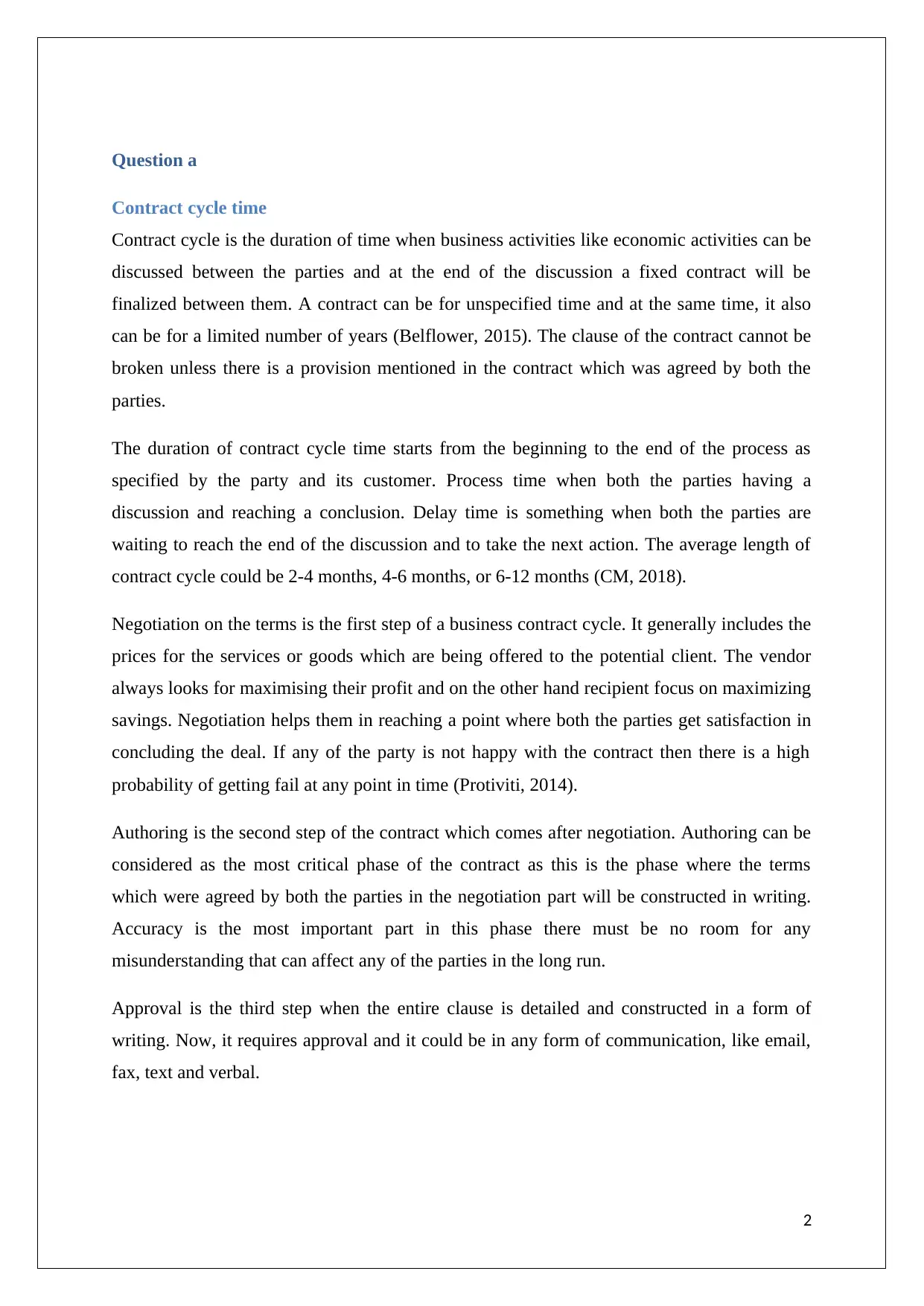
Question a
Contract cycle time
Contract cycle is the duration of time when business activities like economic activities can be
discussed between the parties and at the end of the discussion a fixed contract will be
finalized between them. A contract can be for unspecified time and at the same time, it also
can be for a limited number of years (Belflower, 2015). The clause of the contract cannot be
broken unless there is a provision mentioned in the contract which was agreed by both the
parties.
The duration of contract cycle time starts from the beginning to the end of the process as
specified by the party and its customer. Process time when both the parties having a
discussion and reaching a conclusion. Delay time is something when both the parties are
waiting to reach the end of the discussion and to take the next action. The average length of
contract cycle could be 2-4 months, 4-6 months, or 6-12 months (CM, 2018).
Negotiation on the terms is the first step of a business contract cycle. It generally includes the
prices for the services or goods which are being offered to the potential client. The vendor
always looks for maximising their profit and on the other hand recipient focus on maximizing
savings. Negotiation helps them in reaching a point where both the parties get satisfaction in
concluding the deal. If any of the party is not happy with the contract then there is a high
probability of getting fail at any point in time (Protiviti, 2014).
Authoring is the second step of the contract which comes after negotiation. Authoring can be
considered as the most critical phase of the contract as this is the phase where the terms
which were agreed by both the parties in the negotiation part will be constructed in writing.
Accuracy is the most important part in this phase there must be no room for any
misunderstanding that can affect any of the parties in the long run.
Approval is the third step when the entire clause is detailed and constructed in a form of
writing. Now, it requires approval and it could be in any form of communication, like email,
fax, text and verbal.
2
Contract cycle time
Contract cycle is the duration of time when business activities like economic activities can be
discussed between the parties and at the end of the discussion a fixed contract will be
finalized between them. A contract can be for unspecified time and at the same time, it also
can be for a limited number of years (Belflower, 2015). The clause of the contract cannot be
broken unless there is a provision mentioned in the contract which was agreed by both the
parties.
The duration of contract cycle time starts from the beginning to the end of the process as
specified by the party and its customer. Process time when both the parties having a
discussion and reaching a conclusion. Delay time is something when both the parties are
waiting to reach the end of the discussion and to take the next action. The average length of
contract cycle could be 2-4 months, 4-6 months, or 6-12 months (CM, 2018).
Negotiation on the terms is the first step of a business contract cycle. It generally includes the
prices for the services or goods which are being offered to the potential client. The vendor
always looks for maximising their profit and on the other hand recipient focus on maximizing
savings. Negotiation helps them in reaching a point where both the parties get satisfaction in
concluding the deal. If any of the party is not happy with the contract then there is a high
probability of getting fail at any point in time (Protiviti, 2014).
Authoring is the second step of the contract which comes after negotiation. Authoring can be
considered as the most critical phase of the contract as this is the phase where the terms
which were agreed by both the parties in the negotiation part will be constructed in writing.
Accuracy is the most important part in this phase there must be no room for any
misunderstanding that can affect any of the parties in the long run.
Approval is the third step when the entire clause is detailed and constructed in a form of
writing. Now, it requires approval and it could be in any form of communication, like email,
fax, text and verbal.
2

Question b
Reduce contract cycle time in the firm
There are multiple ways to reduce contract cycle time. The following ideas can help in
reducing cycle time to a firm:
There is a technology called purpose contract management technology which can help in
saving time for creating contracts. As a firm, I would have avoided entering data manually
into a broadsheet or using an automated system. Instead, off I would have been using the
latest technology like uploading the contract in an online tool (Ball, 2013). Some specific
clause and terms can easily be found on the internet and also there is multiple contract
management software that allows using their template that can easily be populated with
conditions and key terms.
Negotiation and drafting a contract often take so much time because the document always
moves between the parties for amendments and their perusal. In order to minimise the delay,
I would prefer using a centralized contract database so that the time can be saved and it is
also secured. Sharing information through email is wastage of time and there is also a high
probability of getting compromised the confidential information (Francklin, 2011). The
administrator of the contract site can monitor the progress on the document using the adult
trail.
The common problem is being faced by the contract management team with the visibility of
the contract data. I would have used an online management solution so that all the relevant
documents could be accessible to every member of the team. Using this solution the visibility
can be improved and it also makes the process faster and easier (Levien, 2012).
Question c
Contract scenario
A contract can be carried out with a third party who will be responsible to keep the total cost
of operations to the barest minimum. A contract needs to be created depicting clearly the
terms and conditions on the basis of legal rules and regulations. Both parties have to agree on
the terms and conditions provided in the agreement. A contract can be valid when there are
offer, consideration and acceptance (Sullivan, 2018). The organization will explain clearly
the work processes which need to be carried out by the contractor. The contractor would
3
Reduce contract cycle time in the firm
There are multiple ways to reduce contract cycle time. The following ideas can help in
reducing cycle time to a firm:
There is a technology called purpose contract management technology which can help in
saving time for creating contracts. As a firm, I would have avoided entering data manually
into a broadsheet or using an automated system. Instead, off I would have been using the
latest technology like uploading the contract in an online tool (Ball, 2013). Some specific
clause and terms can easily be found on the internet and also there is multiple contract
management software that allows using their template that can easily be populated with
conditions and key terms.
Negotiation and drafting a contract often take so much time because the document always
moves between the parties for amendments and their perusal. In order to minimise the delay,
I would prefer using a centralized contract database so that the time can be saved and it is
also secured. Sharing information through email is wastage of time and there is also a high
probability of getting compromised the confidential information (Francklin, 2011). The
administrator of the contract site can monitor the progress on the document using the adult
trail.
The common problem is being faced by the contract management team with the visibility of
the contract data. I would have used an online management solution so that all the relevant
documents could be accessible to every member of the team. Using this solution the visibility
can be improved and it also makes the process faster and easier (Levien, 2012).
Question c
Contract scenario
A contract can be carried out with a third party who will be responsible to keep the total cost
of operations to the barest minimum. A contract needs to be created depicting clearly the
terms and conditions on the basis of legal rules and regulations. Both parties have to agree on
the terms and conditions provided in the agreement. A contract can be valid when there are
offer, consideration and acceptance (Sullivan, 2018). The organization will explain clearly
the work processes which need to be carried out by the contractor. The contractor would
3
Paraphrase This Document
Need a fresh take? Get an instant paraphrase of this document with our AI Paraphraser
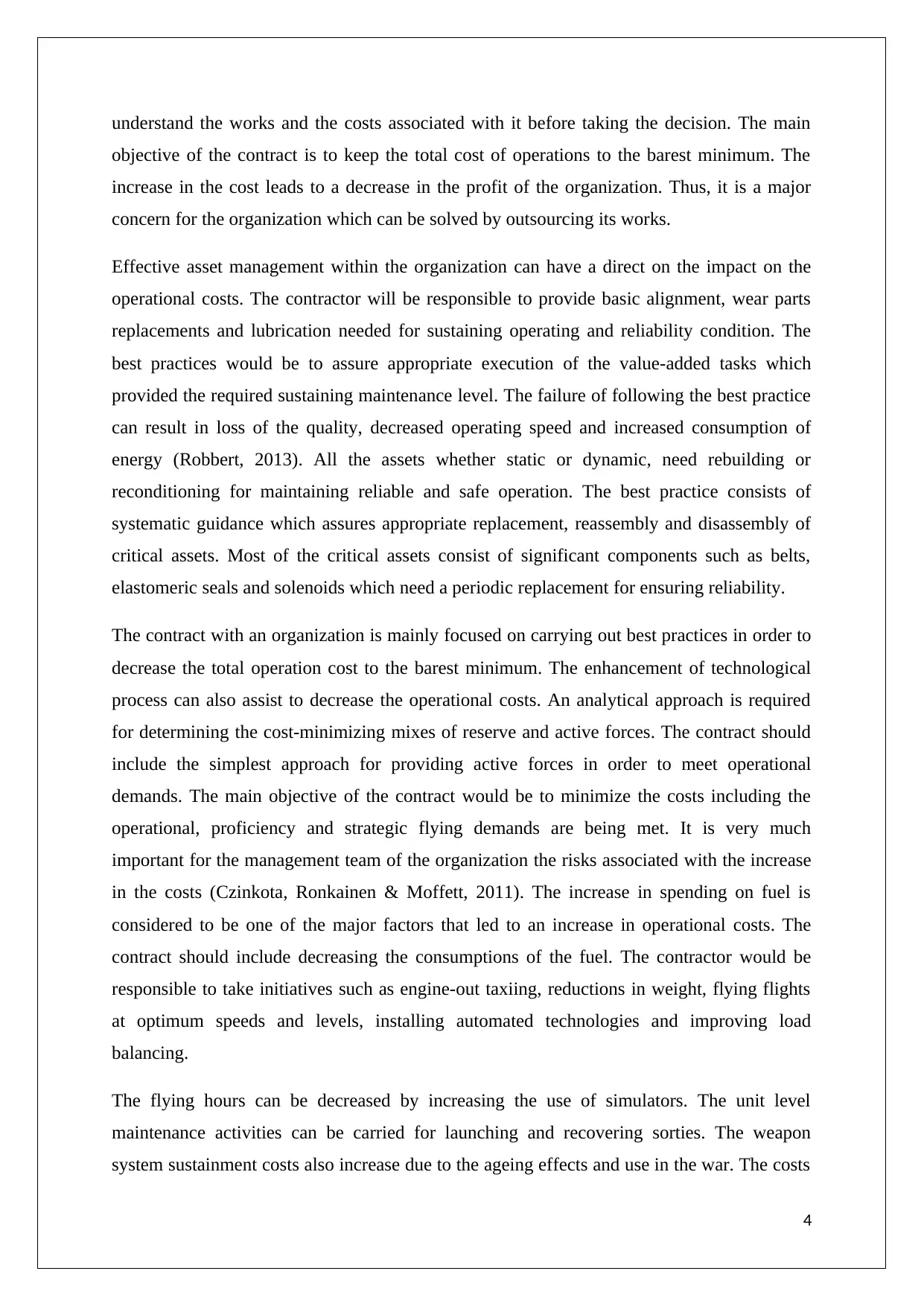
understand the works and the costs associated with it before taking the decision. The main
objective of the contract is to keep the total cost of operations to the barest minimum. The
increase in the cost leads to a decrease in the profit of the organization. Thus, it is a major
concern for the organization which can be solved by outsourcing its works.
Effective asset management within the organization can have a direct on the impact on the
operational costs. The contractor will be responsible to provide basic alignment, wear parts
replacements and lubrication needed for sustaining operating and reliability condition. The
best practices would be to assure appropriate execution of the value-added tasks which
provided the required sustaining maintenance level. The failure of following the best practice
can result in loss of the quality, decreased operating speed and increased consumption of
energy (Robbert, 2013). All the assets whether static or dynamic, need rebuilding or
reconditioning for maintaining reliable and safe operation. The best practice consists of
systematic guidance which assures appropriate replacement, reassembly and disassembly of
critical assets. Most of the critical assets consist of significant components such as belts,
elastomeric seals and solenoids which need a periodic replacement for ensuring reliability.
The contract with an organization is mainly focused on carrying out best practices in order to
decrease the total operation cost to the barest minimum. The enhancement of technological
process can also assist to decrease the operational costs. An analytical approach is required
for determining the cost-minimizing mixes of reserve and active forces. The contract should
include the simplest approach for providing active forces in order to meet operational
demands. The main objective of the contract would be to minimize the costs including the
operational, proficiency and strategic flying demands are being met. It is very much
important for the management team of the organization the risks associated with the increase
in the costs (Czinkota, Ronkainen & Moffett, 2011). The increase in spending on fuel is
considered to be one of the major factors that led to an increase in operational costs. The
contract should include decreasing the consumptions of the fuel. The contractor would be
responsible to take initiatives such as engine-out taxiing, reductions in weight, flying flights
at optimum speeds and levels, installing automated technologies and improving load
balancing.
The flying hours can be decreased by increasing the use of simulators. The unit level
maintenance activities can be carried for launching and recovering sorties. The weapon
system sustainment costs also increase due to the ageing effects and use in the war. The costs
4
objective of the contract is to keep the total cost of operations to the barest minimum. The
increase in the cost leads to a decrease in the profit of the organization. Thus, it is a major
concern for the organization which can be solved by outsourcing its works.
Effective asset management within the organization can have a direct on the impact on the
operational costs. The contractor will be responsible to provide basic alignment, wear parts
replacements and lubrication needed for sustaining operating and reliability condition. The
best practices would be to assure appropriate execution of the value-added tasks which
provided the required sustaining maintenance level. The failure of following the best practice
can result in loss of the quality, decreased operating speed and increased consumption of
energy (Robbert, 2013). All the assets whether static or dynamic, need rebuilding or
reconditioning for maintaining reliable and safe operation. The best practice consists of
systematic guidance which assures appropriate replacement, reassembly and disassembly of
critical assets. Most of the critical assets consist of significant components such as belts,
elastomeric seals and solenoids which need a periodic replacement for ensuring reliability.
The contract with an organization is mainly focused on carrying out best practices in order to
decrease the total operation cost to the barest minimum. The enhancement of technological
process can also assist to decrease the operational costs. An analytical approach is required
for determining the cost-minimizing mixes of reserve and active forces. The contract should
include the simplest approach for providing active forces in order to meet operational
demands. The main objective of the contract would be to minimize the costs including the
operational, proficiency and strategic flying demands are being met. It is very much
important for the management team of the organization the risks associated with the increase
in the costs (Czinkota, Ronkainen & Moffett, 2011). The increase in spending on fuel is
considered to be one of the major factors that led to an increase in operational costs. The
contract should include decreasing the consumptions of the fuel. The contractor would be
responsible to take initiatives such as engine-out taxiing, reductions in weight, flying flights
at optimum speeds and levels, installing automated technologies and improving load
balancing.
The flying hours can be decreased by increasing the use of simulators. The unit level
maintenance activities can be carried for launching and recovering sorties. The weapon
system sustainment costs also increase due to the ageing effects and use in the war. The costs
4
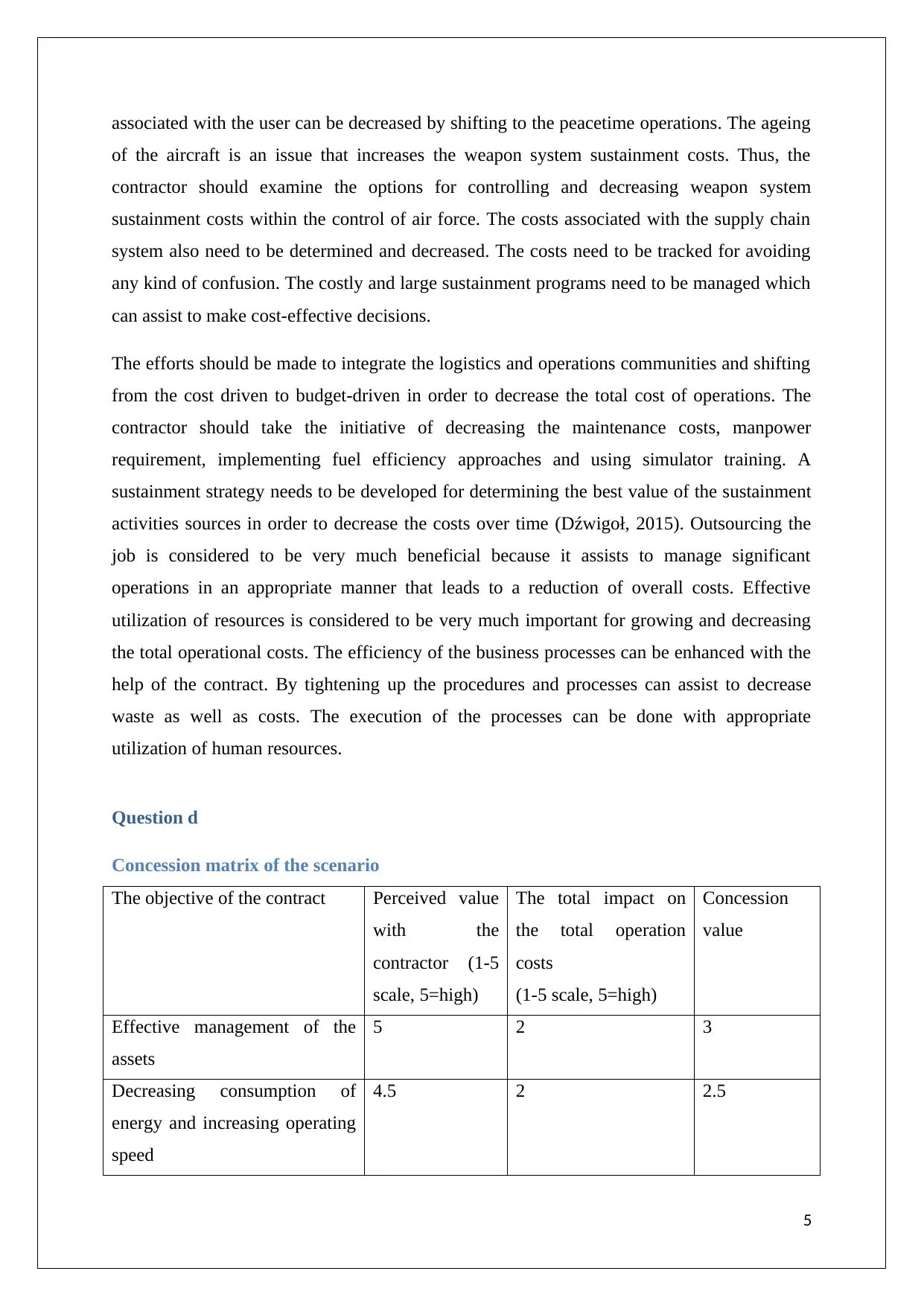
associated with the user can be decreased by shifting to the peacetime operations. The ageing
of the aircraft is an issue that increases the weapon system sustainment costs. Thus, the
contractor should examine the options for controlling and decreasing weapon system
sustainment costs within the control of air force. The costs associated with the supply chain
system also need to be determined and decreased. The costs need to be tracked for avoiding
any kind of confusion. The costly and large sustainment programs need to be managed which
can assist to make cost-effective decisions.
The efforts should be made to integrate the logistics and operations communities and shifting
from the cost driven to budget-driven in order to decrease the total cost of operations. The
contractor should take the initiative of decreasing the maintenance costs, manpower
requirement, implementing fuel efficiency approaches and using simulator training. A
sustainment strategy needs to be developed for determining the best value of the sustainment
activities sources in order to decrease the costs over time (Dźwigoł, 2015). Outsourcing the
job is considered to be very much beneficial because it assists to manage significant
operations in an appropriate manner that leads to a reduction of overall costs. Effective
utilization of resources is considered to be very much important for growing and decreasing
the total operational costs. The efficiency of the business processes can be enhanced with the
help of the contract. By tightening up the procedures and processes can assist to decrease
waste as well as costs. The execution of the processes can be done with appropriate
utilization of human resources.
Question d
Concession matrix of the scenario
The objective of the contract Perceived value
with the
contractor (1-5
scale, 5=high)
The total impact on
the total operation
costs
(1-5 scale, 5=high)
Concession
value
Effective management of the
assets
5 2 3
Decreasing consumption of
energy and increasing operating
speed
4.5 2 2.5
5
of the aircraft is an issue that increases the weapon system sustainment costs. Thus, the
contractor should examine the options for controlling and decreasing weapon system
sustainment costs within the control of air force. The costs associated with the supply chain
system also need to be determined and decreased. The costs need to be tracked for avoiding
any kind of confusion. The costly and large sustainment programs need to be managed which
can assist to make cost-effective decisions.
The efforts should be made to integrate the logistics and operations communities and shifting
from the cost driven to budget-driven in order to decrease the total cost of operations. The
contractor should take the initiative of decreasing the maintenance costs, manpower
requirement, implementing fuel efficiency approaches and using simulator training. A
sustainment strategy needs to be developed for determining the best value of the sustainment
activities sources in order to decrease the costs over time (Dźwigoł, 2015). Outsourcing the
job is considered to be very much beneficial because it assists to manage significant
operations in an appropriate manner that leads to a reduction of overall costs. Effective
utilization of resources is considered to be very much important for growing and decreasing
the total operational costs. The efficiency of the business processes can be enhanced with the
help of the contract. By tightening up the procedures and processes can assist to decrease
waste as well as costs. The execution of the processes can be done with appropriate
utilization of human resources.
Question d
Concession matrix of the scenario
The objective of the contract Perceived value
with the
contractor (1-5
scale, 5=high)
The total impact on
the total operation
costs
(1-5 scale, 5=high)
Concession
value
Effective management of the
assets
5 2 3
Decreasing consumption of
energy and increasing operating
speed
4.5 2 2.5
5

Deployment of technological
processes in order to increase
the operational efficiencies
4 2 2
The use of the simulators for
decreasing the flying hours
3.5 1.5 2
Implementing strategies for
decreasing the weapon system
sustainment costs
3 1.5 1.5
Integration of the operations and
logistics communities in order
to decrease the costs
4 2.5 1.5
The operating activities need to
be consistently tracked and
formally established within both
contracted and organically
activities
4 2.5 1.5
An appropriate collection and
examination of information and
data can assist to facilitate better
and greater visibility to the cost
management
5 4 1
The managers would be held
accountable for describing
changes in both performance
and cost metrics
5 4 1
Setting standards for comparing
the performance and costs
associated with the processes
4 5 -1
6
processes in order to increase
the operational efficiencies
4 2 2
The use of the simulators for
decreasing the flying hours
3.5 1.5 2
Implementing strategies for
decreasing the weapon system
sustainment costs
3 1.5 1.5
Integration of the operations and
logistics communities in order
to decrease the costs
4 2.5 1.5
The operating activities need to
be consistently tracked and
formally established within both
contracted and organically
activities
4 2.5 1.5
An appropriate collection and
examination of information and
data can assist to facilitate better
and greater visibility to the cost
management
5 4 1
The managers would be held
accountable for describing
changes in both performance
and cost metrics
5 4 1
Setting standards for comparing
the performance and costs
associated with the processes
4 5 -1
6
Secure Best Marks with AI Grader
Need help grading? Try our AI Grader for instant feedback on your assignments.

Question e
Analysis of the cost model
A good cost model can help in understanding the true cost model of the supplier and the
actual price for the final product. It also helps in getting a better deal. Either the right project
cost will help the firm in negotiating with the supplier so that the firm can bring the profit
margin to a fair level or the cost might be wrong which will allow the supplier to point out
the right cost data and the firm shall get a better understanding of the actual costs (Eldenburg
& Wolcott, 2009).
A firm will base its cost negotiation on "should cost" model because during negotiations it
can help in negotiating cost saving and can become more than an opportunity. Using should
cost a firm will not only be able to find how much they are spending on each cost component
but also be able to identify the most expensive cost component (Paris, 2010). Then they shall
look into the most expensive components one by one, and will try to find the reason of these
components for being so expensive compared to others so that the firm can decide whether
they can help their supplier in reducing the price or they should go with substitutes.
While purchasing a custom item which is being produced by one supplier only then using
should cost model a fair price of that product can be identified. A should cost can be
considered as a calculation of an estimated price that can be generated by doing research on
cost for materials, cost of labour, overhead cost and margins of profit that could apply on an
item.
If firm’s estimate is getting exceeded with the price quoted by the supplier then its "should
cost" will enable an option for future negotiation. It is very important to know about the
supplier's business because it is highly possible that the supplier can challenge firm’s
assumption so that they can take the cost identification negotiation process back to their side
while the firm has been using should cost model in negotiation (Peng, 2017). It is important
to do a study on every aspect of the item to be sure that the supplier cannot raise any
objection apart from the minor ones and they cannot get an opportunity to raise any objection
regarding the integrity of the model. Whenever should cost model is getting challenged by
the supplier the model starts working in the favour of the buyer because the supplier has
started using the model of buyer and data should cost must not be used to set a price which is
unachievable, in this situation cost model could be a good option.
7
Analysis of the cost model
A good cost model can help in understanding the true cost model of the supplier and the
actual price for the final product. It also helps in getting a better deal. Either the right project
cost will help the firm in negotiating with the supplier so that the firm can bring the profit
margin to a fair level or the cost might be wrong which will allow the supplier to point out
the right cost data and the firm shall get a better understanding of the actual costs (Eldenburg
& Wolcott, 2009).
A firm will base its cost negotiation on "should cost" model because during negotiations it
can help in negotiating cost saving and can become more than an opportunity. Using should
cost a firm will not only be able to find how much they are spending on each cost component
but also be able to identify the most expensive cost component (Paris, 2010). Then they shall
look into the most expensive components one by one, and will try to find the reason of these
components for being so expensive compared to others so that the firm can decide whether
they can help their supplier in reducing the price or they should go with substitutes.
While purchasing a custom item which is being produced by one supplier only then using
should cost model a fair price of that product can be identified. A should cost can be
considered as a calculation of an estimated price that can be generated by doing research on
cost for materials, cost of labour, overhead cost and margins of profit that could apply on an
item.
If firm’s estimate is getting exceeded with the price quoted by the supplier then its "should
cost" will enable an option for future negotiation. It is very important to know about the
supplier's business because it is highly possible that the supplier can challenge firm’s
assumption so that they can take the cost identification negotiation process back to their side
while the firm has been using should cost model in negotiation (Peng, 2017). It is important
to do a study on every aspect of the item to be sure that the supplier cannot raise any
objection apart from the minor ones and they cannot get an opportunity to raise any objection
regarding the integrity of the model. Whenever should cost model is getting challenged by
the supplier the model starts working in the favour of the buyer because the supplier has
started using the model of buyer and data should cost must not be used to set a price which is
unachievable, in this situation cost model could be a good option.
7
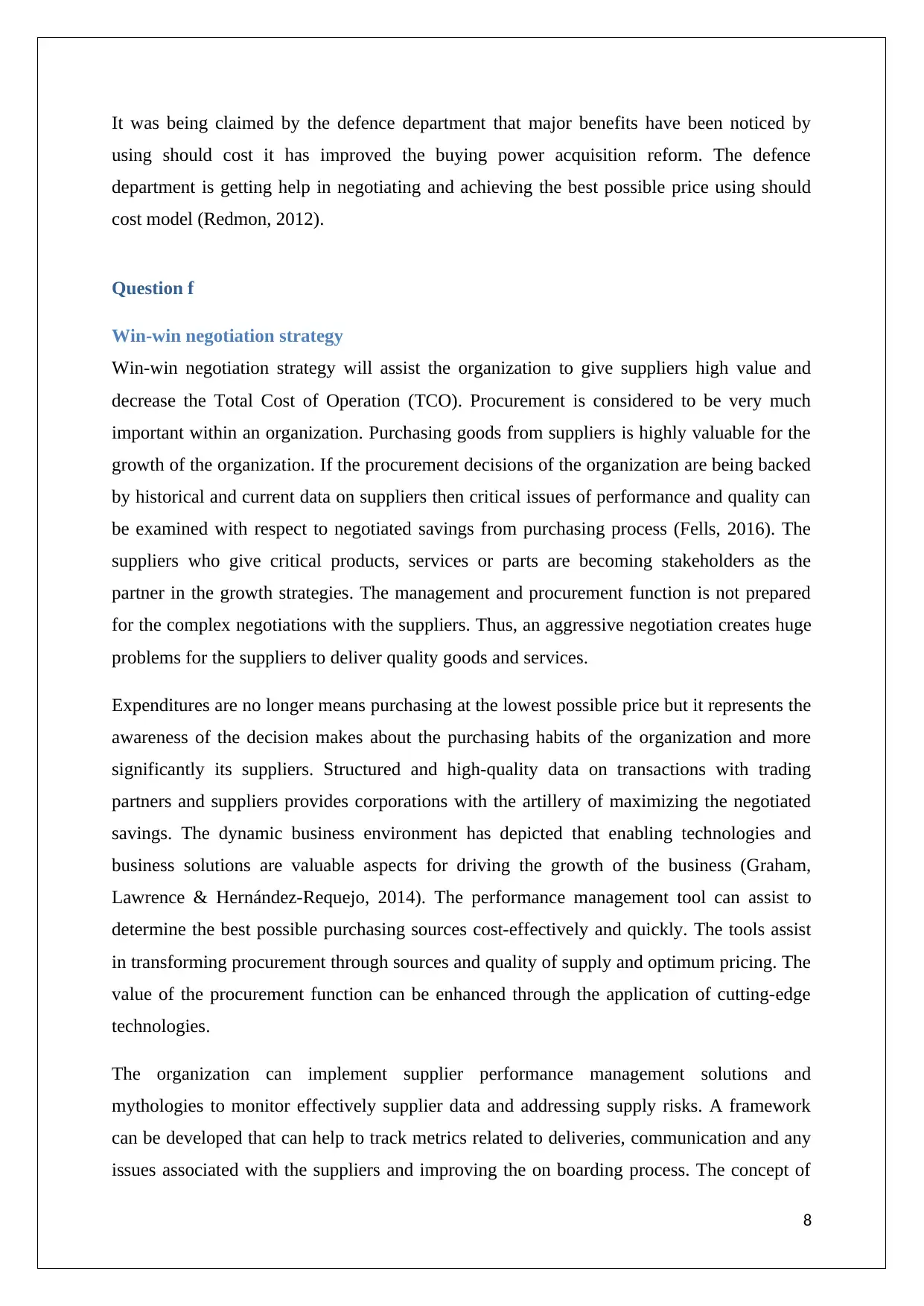
It was being claimed by the defence department that major benefits have been noticed by
using should cost it has improved the buying power acquisition reform. The defence
department is getting help in negotiating and achieving the best possible price using should
cost model (Redmon, 2012).
Question f
Win-win negotiation strategy
Win-win negotiation strategy will assist the organization to give suppliers high value and
decrease the Total Cost of Operation (TCO). Procurement is considered to be very much
important within an organization. Purchasing goods from suppliers is highly valuable for the
growth of the organization. If the procurement decisions of the organization are being backed
by historical and current data on suppliers then critical issues of performance and quality can
be examined with respect to negotiated savings from purchasing process (Fells, 2016). The
suppliers who give critical products, services or parts are becoming stakeholders as the
partner in the growth strategies. The management and procurement function is not prepared
for the complex negotiations with the suppliers. Thus, an aggressive negotiation creates huge
problems for the suppliers to deliver quality goods and services.
Expenditures are no longer means purchasing at the lowest possible price but it represents the
awareness of the decision makes about the purchasing habits of the organization and more
significantly its suppliers. Structured and high-quality data on transactions with trading
partners and suppliers provides corporations with the artillery of maximizing the negotiated
savings. The dynamic business environment has depicted that enabling technologies and
business solutions are valuable aspects for driving the growth of the business (Graham,
Lawrence & Hernández-Requejo, 2014). The performance management tool can assist to
determine the best possible purchasing sources cost-effectively and quickly. The tools assist
in transforming procurement through sources and quality of supply and optimum pricing. The
value of the procurement function can be enhanced through the application of cutting-edge
technologies.
The organization can implement supplier performance management solutions and
mythologies to monitor effectively supplier data and addressing supply risks. A framework
can be developed that can help to track metrics related to deliveries, communication and any
issues associated with the suppliers and improving the on boarding process. The concept of
8
using should cost it has improved the buying power acquisition reform. The defence
department is getting help in negotiating and achieving the best possible price using should
cost model (Redmon, 2012).
Question f
Win-win negotiation strategy
Win-win negotiation strategy will assist the organization to give suppliers high value and
decrease the Total Cost of Operation (TCO). Procurement is considered to be very much
important within an organization. Purchasing goods from suppliers is highly valuable for the
growth of the organization. If the procurement decisions of the organization are being backed
by historical and current data on suppliers then critical issues of performance and quality can
be examined with respect to negotiated savings from purchasing process (Fells, 2016). The
suppliers who give critical products, services or parts are becoming stakeholders as the
partner in the growth strategies. The management and procurement function is not prepared
for the complex negotiations with the suppliers. Thus, an aggressive negotiation creates huge
problems for the suppliers to deliver quality goods and services.
Expenditures are no longer means purchasing at the lowest possible price but it represents the
awareness of the decision makes about the purchasing habits of the organization and more
significantly its suppliers. Structured and high-quality data on transactions with trading
partners and suppliers provides corporations with the artillery of maximizing the negotiated
savings. The dynamic business environment has depicted that enabling technologies and
business solutions are valuable aspects for driving the growth of the business (Graham,
Lawrence & Hernández-Requejo, 2014). The performance management tool can assist to
determine the best possible purchasing sources cost-effectively and quickly. The tools assist
in transforming procurement through sources and quality of supply and optimum pricing. The
value of the procurement function can be enhanced through the application of cutting-edge
technologies.
The organization can implement supplier performance management solutions and
mythologies to monitor effectively supplier data and addressing supply risks. A framework
can be developed that can help to track metrics related to deliveries, communication and any
issues associated with the suppliers and improving the on boarding process. The concept of
8

creating an optimum sourcing environment in order to meet the needs with the assistance of
the suppliers is considered to be very much important for the organization (Paranikas,
Whiteford, Tevelson & Belz, 2015). The procurement needs to be leveraged in such a manner
that the organization gets the benefit and become an efficient and strong negotiator. It is
being found that successful negotiations are essential for the growth and success of a business
organization. It plays a significant role in mutually building collaborative and beneficial
relationships with the suppliers (Staff, 2018).
The organization before carrying out the negotiation should determine alternatives or talk to
other suppliers before setting the prices, terms and conditions of the contract. The
determination and setting clear objectives are important before carrying out the negotiation
process. The plan should be based on creating benefits for both parties. Both the parties need
to be empathetic, optimistic and positive with each other (Reddy, 2018). The organization
should understand the position and interests of the supplier. Information and data need to be
gathered on uncertainties that can exist with the suppliers. The application of appropriate
strategy can assist to deal with the situations.
The contract should be carried out fairly and honestly on the basis of terms and conditions.
During the negotiation process, it is important to discuss complex issues at the first and
determining solution for them. Both parties are expected to be respected by each other during
the entire process of negotiation (Rojot, 2016). Developing a long term relationship can be
beneficial in future. The organisation should also focus on bringing new value to the supplier.
The negotiation process needs to be carried out by keeping in view the benefits for both the
parties. An appropriate negotiation strategy can assist the organization to reduce total
operating costs and increase the value of the suppliers.
Question g
The decreasing cost in the firm's supply chain
Profit can be increased without increasing sale and this can only be possible by reducing
supply cost. There are certain things which will come undersupply cost like the cost of
shipping, cost of storage, recovering them and supplies themselves. Supply chain expenses
can be reduced by controlling every step of the supply process (Blanchard, 2013).
9
the suppliers is considered to be very much important for the organization (Paranikas,
Whiteford, Tevelson & Belz, 2015). The procurement needs to be leveraged in such a manner
that the organization gets the benefit and become an efficient and strong negotiator. It is
being found that successful negotiations are essential for the growth and success of a business
organization. It plays a significant role in mutually building collaborative and beneficial
relationships with the suppliers (Staff, 2018).
The organization before carrying out the negotiation should determine alternatives or talk to
other suppliers before setting the prices, terms and conditions of the contract. The
determination and setting clear objectives are important before carrying out the negotiation
process. The plan should be based on creating benefits for both parties. Both the parties need
to be empathetic, optimistic and positive with each other (Reddy, 2018). The organization
should understand the position and interests of the supplier. Information and data need to be
gathered on uncertainties that can exist with the suppliers. The application of appropriate
strategy can assist to deal with the situations.
The contract should be carried out fairly and honestly on the basis of terms and conditions.
During the negotiation process, it is important to discuss complex issues at the first and
determining solution for them. Both parties are expected to be respected by each other during
the entire process of negotiation (Rojot, 2016). Developing a long term relationship can be
beneficial in future. The organisation should also focus on bringing new value to the supplier.
The negotiation process needs to be carried out by keeping in view the benefits for both the
parties. An appropriate negotiation strategy can assist the organization to reduce total
operating costs and increase the value of the suppliers.
Question g
The decreasing cost in the firm's supply chain
Profit can be increased without increasing sale and this can only be possible by reducing
supply cost. There are certain things which will come undersupply cost like the cost of
shipping, cost of storage, recovering them and supplies themselves. Supply chain expenses
can be reduced by controlling every step of the supply process (Blanchard, 2013).
9
Paraphrase This Document
Need a fresh take? Get an instant paraphrase of this document with our AI Paraphraser
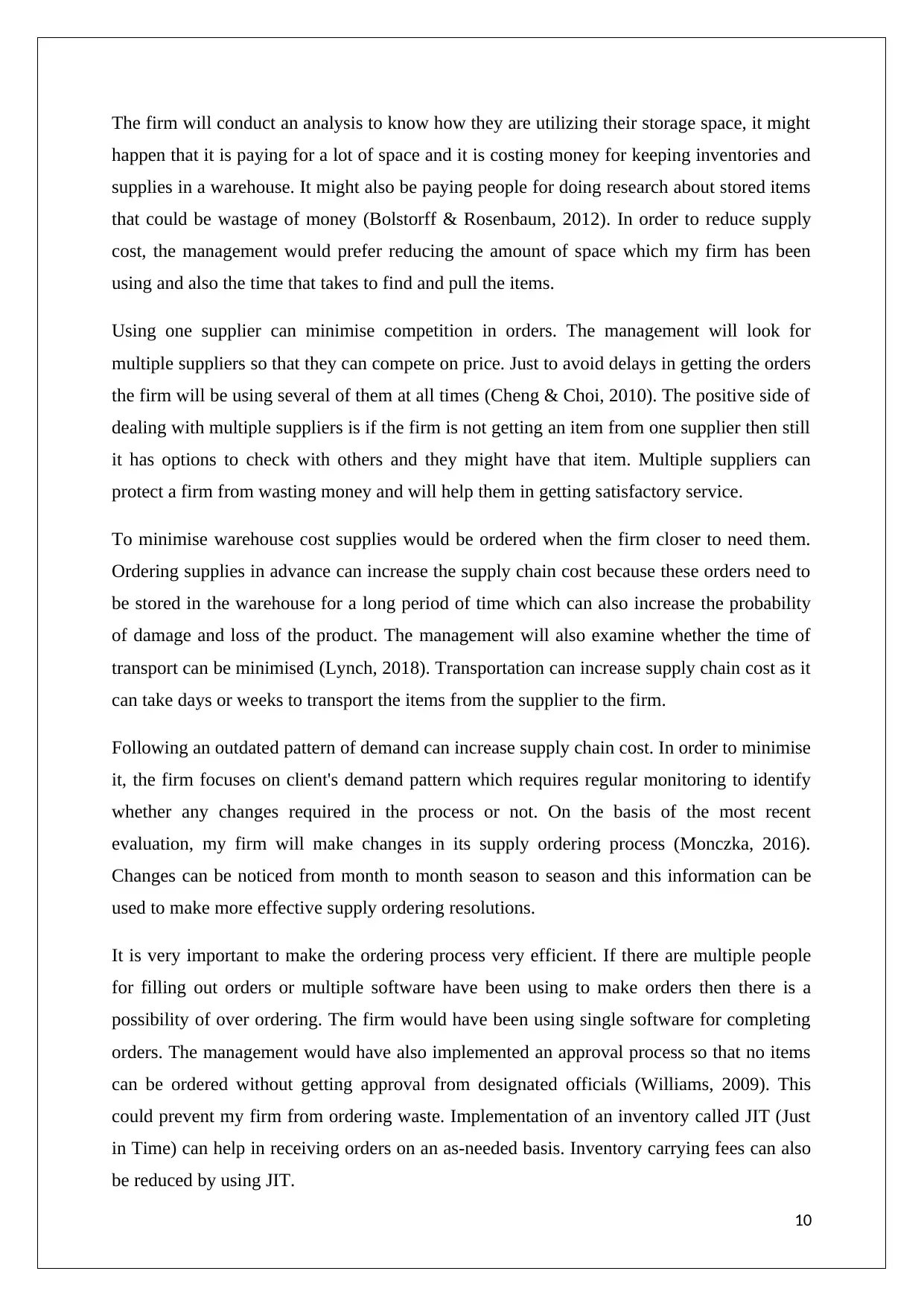
The firm will conduct an analysis to know how they are utilizing their storage space, it might
happen that it is paying for a lot of space and it is costing money for keeping inventories and
supplies in a warehouse. It might also be paying people for doing research about stored items
that could be wastage of money (Bolstorff & Rosenbaum, 2012). In order to reduce supply
cost, the management would prefer reducing the amount of space which my firm has been
using and also the time that takes to find and pull the items.
Using one supplier can minimise competition in orders. The management will look for
multiple suppliers so that they can compete on price. Just to avoid delays in getting the orders
the firm will be using several of them at all times (Cheng & Choi, 2010). The positive side of
dealing with multiple suppliers is if the firm is not getting an item from one supplier then still
it has options to check with others and they might have that item. Multiple suppliers can
protect a firm from wasting money and will help them in getting satisfactory service.
To minimise warehouse cost supplies would be ordered when the firm closer to need them.
Ordering supplies in advance can increase the supply chain cost because these orders need to
be stored in the warehouse for a long period of time which can also increase the probability
of damage and loss of the product. The management will also examine whether the time of
transport can be minimised (Lynch, 2018). Transportation can increase supply chain cost as it
can take days or weeks to transport the items from the supplier to the firm.
Following an outdated pattern of demand can increase supply chain cost. In order to minimise
it, the firm focuses on client's demand pattern which requires regular monitoring to identify
whether any changes required in the process or not. On the basis of the most recent
evaluation, my firm will make changes in its supply ordering process (Monczka, 2016).
Changes can be noticed from month to month season to season and this information can be
used to make more effective supply ordering resolutions.
It is very important to make the ordering process very efficient. If there are multiple people
for filling out orders or multiple software have been using to make orders then there is a
possibility of over ordering. The firm would have been using single software for completing
orders. The management would have also implemented an approval process so that no items
can be ordered without getting approval from designated officials (Williams, 2009). This
could prevent my firm from ordering waste. Implementation of an inventory called JIT (Just
in Time) can help in receiving orders on an as-needed basis. Inventory carrying fees can also
be reduced by using JIT.
10
happen that it is paying for a lot of space and it is costing money for keeping inventories and
supplies in a warehouse. It might also be paying people for doing research about stored items
that could be wastage of money (Bolstorff & Rosenbaum, 2012). In order to reduce supply
cost, the management would prefer reducing the amount of space which my firm has been
using and also the time that takes to find and pull the items.
Using one supplier can minimise competition in orders. The management will look for
multiple suppliers so that they can compete on price. Just to avoid delays in getting the orders
the firm will be using several of them at all times (Cheng & Choi, 2010). The positive side of
dealing with multiple suppliers is if the firm is not getting an item from one supplier then still
it has options to check with others and they might have that item. Multiple suppliers can
protect a firm from wasting money and will help them in getting satisfactory service.
To minimise warehouse cost supplies would be ordered when the firm closer to need them.
Ordering supplies in advance can increase the supply chain cost because these orders need to
be stored in the warehouse for a long period of time which can also increase the probability
of damage and loss of the product. The management will also examine whether the time of
transport can be minimised (Lynch, 2018). Transportation can increase supply chain cost as it
can take days or weeks to transport the items from the supplier to the firm.
Following an outdated pattern of demand can increase supply chain cost. In order to minimise
it, the firm focuses on client's demand pattern which requires regular monitoring to identify
whether any changes required in the process or not. On the basis of the most recent
evaluation, my firm will make changes in its supply ordering process (Monczka, 2016).
Changes can be noticed from month to month season to season and this information can be
used to make more effective supply ordering resolutions.
It is very important to make the ordering process very efficient. If there are multiple people
for filling out orders or multiple software have been using to make orders then there is a
possibility of over ordering. The firm would have been using single software for completing
orders. The management would have also implemented an approval process so that no items
can be ordered without getting approval from designated officials (Williams, 2009). This
could prevent my firm from ordering waste. Implementation of an inventory called JIT (Just
in Time) can help in receiving orders on an as-needed basis. Inventory carrying fees can also
be reduced by using JIT.
10
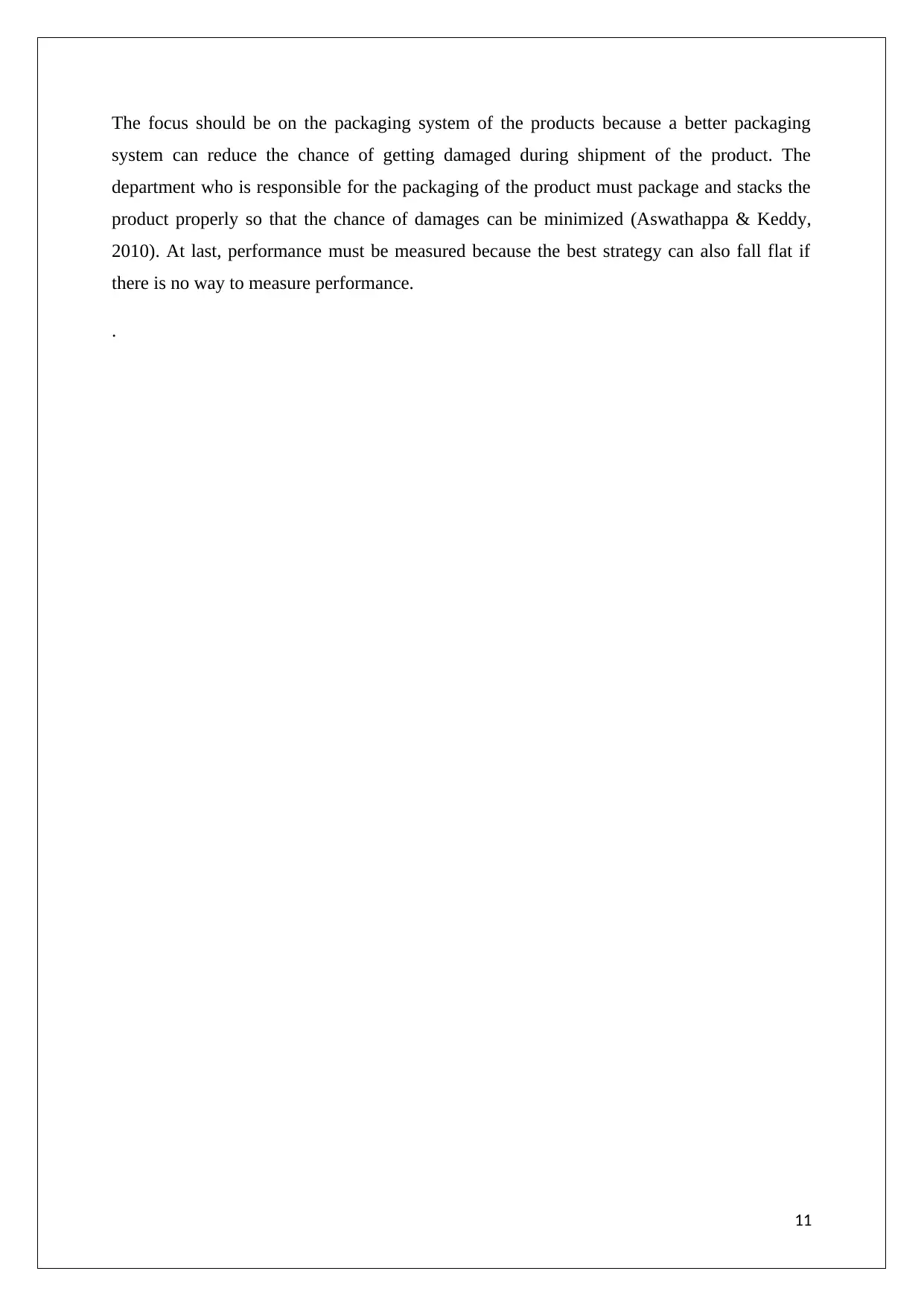
The focus should be on the packaging system of the products because a better packaging
system can reduce the chance of getting damaged during shipment of the product. The
department who is responsible for the packaging of the product must package and stacks the
product properly so that the chance of damages can be minimized (Aswathappa & Keddy,
2010). At last, performance must be measured because the best strategy can also fall flat if
there is no way to measure performance.
.
11
system can reduce the chance of getting damaged during shipment of the product. The
department who is responsible for the packaging of the product must package and stacks the
product properly so that the chance of damages can be minimized (Aswathappa & Keddy,
2010). At last, performance must be measured because the best strategy can also fall flat if
there is no way to measure performance.
.
11
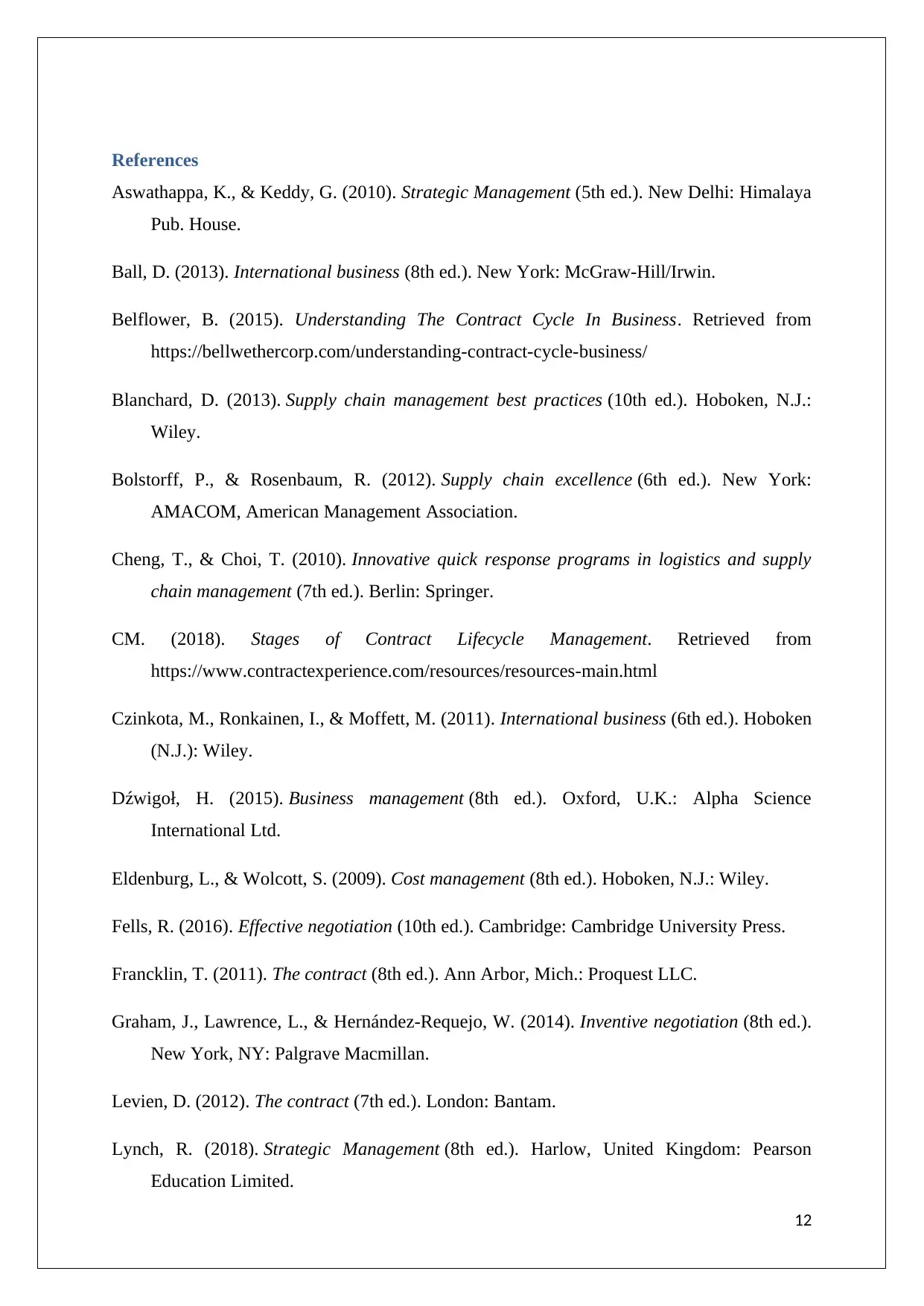
References
Aswathappa, K., & Keddy, G. (2010). Strategic Management (5th ed.). New Delhi: Himalaya
Pub. House.
Ball, D. (2013). International business (8th ed.). New York: McGraw-Hill/Irwin.
Belflower, B. (2015). Understanding The Contract Cycle In Business. Retrieved from
https://bellwethercorp.com/understanding-contract-cycle-business/
Blanchard, D. (2013). Supply chain management best practices (10th ed.). Hoboken, N.J.:
Wiley.
Bolstorff, P., & Rosenbaum, R. (2012). Supply chain excellence (6th ed.). New York:
AMACOM, American Management Association.
Cheng, T., & Choi, T. (2010). Innovative quick response programs in logistics and supply
chain management (7th ed.). Berlin: Springer.
CM. (2018). Stages of Contract Lifecycle Management. Retrieved from
https://www.contractexperience.com/resources/resources-main.html
Czinkota, M., Ronkainen, I., & Moffett, M. (2011). International business (6th ed.). Hoboken
(N.J.): Wiley.
Dźwigoł, H. (2015). Business management (8th ed.). Oxford, U.K.: Alpha Science
International Ltd.
Eldenburg, L., & Wolcott, S. (2009). Cost management (8th ed.). Hoboken, N.J.: Wiley.
Fells, R. (2016). Effective negotiation (10th ed.). Cambridge: Cambridge University Press.
Francklin, T. (2011). The contract (8th ed.). Ann Arbor, Mich.: Proquest LLC.
Graham, J., Lawrence, L., & Hernández-Requejo, W. (2014). Inventive negotiation (8th ed.).
New York, NY: Palgrave Macmillan.
Levien, D. (2012). The contract (7th ed.). London: Bantam.
Lynch, R. (2018). Strategic Management (8th ed.). Harlow, United Kingdom: Pearson
Education Limited.
12
Aswathappa, K., & Keddy, G. (2010). Strategic Management (5th ed.). New Delhi: Himalaya
Pub. House.
Ball, D. (2013). International business (8th ed.). New York: McGraw-Hill/Irwin.
Belflower, B. (2015). Understanding The Contract Cycle In Business. Retrieved from
https://bellwethercorp.com/understanding-contract-cycle-business/
Blanchard, D. (2013). Supply chain management best practices (10th ed.). Hoboken, N.J.:
Wiley.
Bolstorff, P., & Rosenbaum, R. (2012). Supply chain excellence (6th ed.). New York:
AMACOM, American Management Association.
Cheng, T., & Choi, T. (2010). Innovative quick response programs in logistics and supply
chain management (7th ed.). Berlin: Springer.
CM. (2018). Stages of Contract Lifecycle Management. Retrieved from
https://www.contractexperience.com/resources/resources-main.html
Czinkota, M., Ronkainen, I., & Moffett, M. (2011). International business (6th ed.). Hoboken
(N.J.): Wiley.
Dźwigoł, H. (2015). Business management (8th ed.). Oxford, U.K.: Alpha Science
International Ltd.
Eldenburg, L., & Wolcott, S. (2009). Cost management (8th ed.). Hoboken, N.J.: Wiley.
Fells, R. (2016). Effective negotiation (10th ed.). Cambridge: Cambridge University Press.
Francklin, T. (2011). The contract (8th ed.). Ann Arbor, Mich.: Proquest LLC.
Graham, J., Lawrence, L., & Hernández-Requejo, W. (2014). Inventive negotiation (8th ed.).
New York, NY: Palgrave Macmillan.
Levien, D. (2012). The contract (7th ed.). London: Bantam.
Lynch, R. (2018). Strategic Management (8th ed.). Harlow, United Kingdom: Pearson
Education Limited.
12
Secure Best Marks with AI Grader
Need help grading? Try our AI Grader for instant feedback on your assignments.
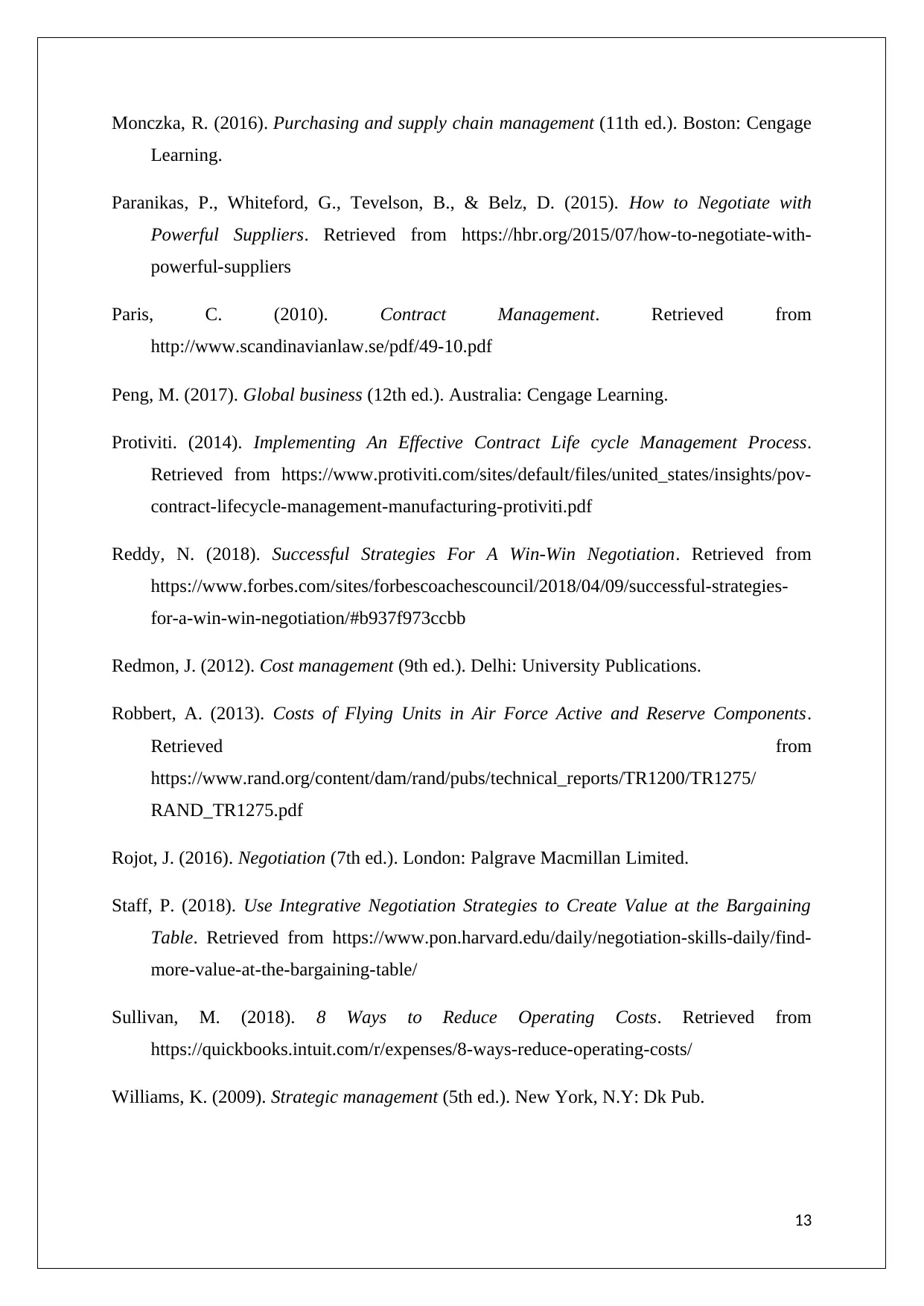
Monczka, R. (2016). Purchasing and supply chain management (11th ed.). Boston: Cengage
Learning.
Paranikas, P., Whiteford, G., Tevelson, B., & Belz, D. (2015). How to Negotiate with
Powerful Suppliers. Retrieved from https://hbr.org/2015/07/how-to-negotiate-with-
powerful-suppliers
Paris, C. (2010). Contract Management. Retrieved from
http://www.scandinavianlaw.se/pdf/49-10.pdf
Peng, M. (2017). Global business (12th ed.). Australia: Cengage Learning.
Protiviti. (2014). Implementing An Effective Contract Life cycle Management Process.
Retrieved from https://www.protiviti.com/sites/default/files/united_states/insights/pov-
contract-lifecycle-management-manufacturing-protiviti.pdf
Reddy, N. (2018). Successful Strategies For A Win-Win Negotiation. Retrieved from
https://www.forbes.com/sites/forbescoachescouncil/2018/04/09/successful-strategies-
for-a-win-win-negotiation/#b937f973ccbb
Redmon, J. (2012). Cost management (9th ed.). Delhi: University Publications.
Robbert, A. (2013). Costs of Flying Units in Air Force Active and Reserve Components.
Retrieved from
https://www.rand.org/content/dam/rand/pubs/technical_reports/TR1200/TR1275/
RAND_TR1275.pdf
Rojot, J. (2016). Negotiation (7th ed.). London: Palgrave Macmillan Limited.
Staff, P. (2018). Use Integrative Negotiation Strategies to Create Value at the Bargaining
Table. Retrieved from https://www.pon.harvard.edu/daily/negotiation-skills-daily/find-
more-value-at-the-bargaining-table/
Sullivan, M. (2018). 8 Ways to Reduce Operating Costs. Retrieved from
https://quickbooks.intuit.com/r/expenses/8-ways-reduce-operating-costs/
Williams, K. (2009). Strategic management (5th ed.). New York, N.Y: Dk Pub.
13
Learning.
Paranikas, P., Whiteford, G., Tevelson, B., & Belz, D. (2015). How to Negotiate with
Powerful Suppliers. Retrieved from https://hbr.org/2015/07/how-to-negotiate-with-
powerful-suppliers
Paris, C. (2010). Contract Management. Retrieved from
http://www.scandinavianlaw.se/pdf/49-10.pdf
Peng, M. (2017). Global business (12th ed.). Australia: Cengage Learning.
Protiviti. (2014). Implementing An Effective Contract Life cycle Management Process.
Retrieved from https://www.protiviti.com/sites/default/files/united_states/insights/pov-
contract-lifecycle-management-manufacturing-protiviti.pdf
Reddy, N. (2018). Successful Strategies For A Win-Win Negotiation. Retrieved from
https://www.forbes.com/sites/forbescoachescouncil/2018/04/09/successful-strategies-
for-a-win-win-negotiation/#b937f973ccbb
Redmon, J. (2012). Cost management (9th ed.). Delhi: University Publications.
Robbert, A. (2013). Costs of Flying Units in Air Force Active and Reserve Components.
Retrieved from
https://www.rand.org/content/dam/rand/pubs/technical_reports/TR1200/TR1275/
RAND_TR1275.pdf
Rojot, J. (2016). Negotiation (7th ed.). London: Palgrave Macmillan Limited.
Staff, P. (2018). Use Integrative Negotiation Strategies to Create Value at the Bargaining
Table. Retrieved from https://www.pon.harvard.edu/daily/negotiation-skills-daily/find-
more-value-at-the-bargaining-table/
Sullivan, M. (2018). 8 Ways to Reduce Operating Costs. Retrieved from
https://quickbooks.intuit.com/r/expenses/8-ways-reduce-operating-costs/
Williams, K. (2009). Strategic management (5th ed.). New York, N.Y: Dk Pub.
13
1 out of 14
Related Documents
Your All-in-One AI-Powered Toolkit for Academic Success.
+13062052269
info@desklib.com
Available 24*7 on WhatsApp / Email
![[object Object]](/_next/static/media/star-bottom.7253800d.svg)
Unlock your academic potential
© 2024 | Zucol Services PVT LTD | All rights reserved.





